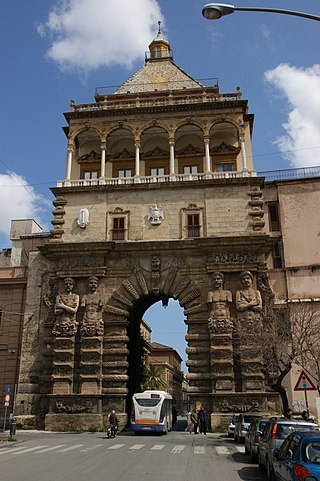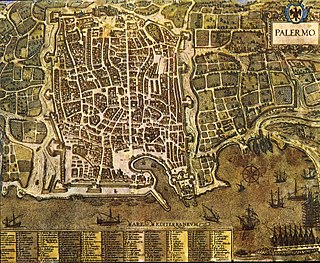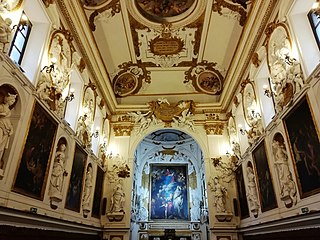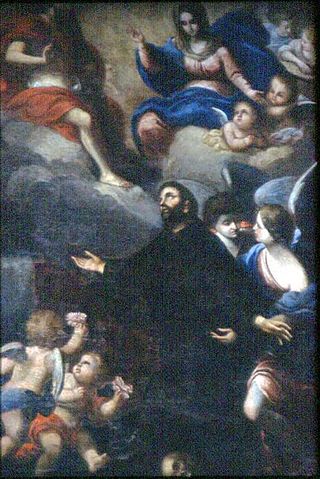
The Church of Saint Mary of Pity is a Baroque church of Palermo. It is located at the corner of Via Alloro and Via Torremuzza in the quarter of the Kalsa, within the historic centre of Palermo.

The Church of Saint Ursula of the Blacks is a Baroque-style, Roman Catholic church located in the central Via Maqueda #110, adjacent to the Palazzo Comitini, in the quarter of the Albergaria, within the historic centre of Palermo, Region of Sicily, Italy.

The Church of Saint Nympha is a Baroque-Mannerist church of Palermo. The facade rises on Via Maqueda, a block north of the central intersection known as the Quattro Canti, in the quarter of Seralcadi, within the historic centre of Palermo. The church belongs to the Camillians.

Porta Nuova is a monumental city gate of Palermo. It represents the entrance of the Cassaro from Corso Calatafimi and is located beside Palazzo dei Normanni, royal palace of Palermo. The gate was built to celebrate Charles V's conquest of Tunis (1535) and his visit to the capital of the Kingdom of Sicily.

The Admiral's Bridge is a medieval bridge of Palermo, located in Piazza Scaffa. It was built over the Oreto River during the era of the Norman Sicily by the ammiratus ammiratorum George of Antioch. In 2015, it became a UNESCO World Heritage Site as part of a series of nine civil and religious structures inscribed as Arab-Norman Palermo and the Cathedral Churches of Cefalù and Monreale.

The Cassaro is the most ancient street of Palermo. From the late 16th century the street also had the name Via Toledo. Following the unification of Italy, it was officially renamed Via Vittorio Emanuele II, but the old and distinctive name is still in use. The street is rooted in the age of the foundation of Palermo by the Phoenicians. It provides access to a number of important sights, including the Royal Palace and the Cathedral, two UNESCO World Heritage Sites.

The Church of Saint Matthew is a Baroque-style, Roman Catholic church of Palermo, region of Sicily, Italy. It is located in the main street of the city, the ancient Cassaro now Corso Vittorio Emanuele, in the quarter of the Loggia, about a block east of the Quattro Canti, within the historic centre of Palermo.

The Church of Saint Ignatius is a Baroque church of Palermo. It is located in the ancient neighborhood of the Olivella, in the quarter of the Loggia, within the historic centre of Palermo.

The Oratory of the Rosary of Saint Dominic is a Baroque oratory of Palermo. It is located near the Church of Saint Dominic, in the quarter of the Loggia, within the historic centre of Palermo.

Simone De Wobreck was a 16th-century Flemish painter, whose known works all come from his long period in Sicily.
The Diocesan Museum of Palermo is a museum of religious art in Palermo on Sicily, housed in a number of rooms in the Palazzo Arcivescovile opposite Palermo Cathedral.

Andrea Carrera or Carreca was an Italian Baroque painter mainly active in Sicily. He was born in Trapani and died in Palermo.

Paolo Amato was an Italian Baroque and Rococo architect. He is also notable as author of the treatise La Nuova Pratica di Prospettiva, published in Palermo in 1732.

Gaspare Guercio was an Italian artist, nicknamed 'Guercio' and a major proponent of the Sicilian Baroque. He was principally a sculptor but also a designer of decorative schemes for architectural projects. He collaborated with his pupil Gaspare Serpotta, father of the more famous Giacomo Serpotta.

Santa Maria di Gesù (Italian) is a Baroque, Roman Catholic parish church in Palermo, region of Sicily, Italy. It faces piazza Beati Paoli al Capo in the Capo quarter.
The Palazzo Filangeri-Cutò is a Baroque-style aristocratic palace located on via Maqueda 26 in the ancient quarter of Albergheria of central Palermo, region of Sicily, Italy. Once the urban palace of a wealthy and prominent family, since the 19th-century the palace has been subdivided into numerous apartments and businesses, and in dire need of restoration.

The Palazzo Celestri di Santacroce, also known as the Palazzo Sant'Elia is a Baroque-style aristocratic palace located on via Maqueda 90 in the ancient quarter of Kalsa of central Palermo, region of Sicily, Italy. Once the urban palace of a wealthy and prominent family, a large portion of the palace is now used for exhibitions and private functions. The palace is diagonal to the Southeast of the Palazzo Comitini, and just a block north of the church of the Assunta.

The Oratorio della Carità di San Pietro is a Baroque chapel or prayer room located on Via Maqueda #206, adjacent to the church of Santa Ninfa dei Crociferi, in the ancient quarter of Seralcadi of Palermo, region of Sicily, Italy.

Madonna dei Rimedi is a Baroque-style, Roman Catholic Sanctuary-church, established and still affiliated with the Discalced Carmelite order, located on Piazza Indipendenza # 9, in Palermo, region of Sicily, Italy.


























